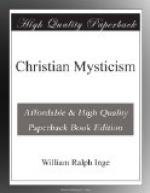The foregoing analysis of St. Paul’s teaching has, I hope, justified the statement that all the essentials of Mysticism are to be found in his Epistles. But there are also two points in which his authority has been claimed for false and mischievous developments of Mysticism. These two points it will be well to consider before leaving the subject.
The first is a contempt for the historical framework of Christianity. We have already seen how strongly St. John warns us against this perversion of spiritual religion. But those numerous sects and individual thinkers who have disregarded this warning, have often appealed to the authority of St. Paul, who in the Second Epistle to the Corinthians says, “Even though we have known Christ after the flesh, yet now we know Him so no more.” Here, they say, is a distinct admission that the worship of the historical Christ, “the man Christ Jesus,” is a stage to be passed through and then left behind. There is just this substratum of truth in a very mischievous error, that St. Paul does tell us[100] that he began to teach the Corinthians by giving them in the simplest possible form the story of “Jesus Christ and Him crucified.” The “mysteries” of the faith, the “wisdom” which only the “perfect” can understand, were deferred till the converts had learned their first lessons. But if we look at the passage in question, which has shocked and perplexed many good Christians, we shall find that St. Paul is not drawing a contrast between the earthly and the heavenly Christ, bidding us worship the Second Person of the Trinity, the same yesterday, to-day, and for ever, and to cease to contemplate the Cross on Calvary. He is distinguishing rather between the sensuous presentation of the facts of Christ’s life, and a deeper realisation of their import. It should be our aim to “know no man after the flesh”; that is to say, we should try to think of human beings as what they are, immortal spirits, sharers with us of a common life and a common hope, not as what they appear to our eyes. And the same principle applies to our thoughts about Christ. To know Christ after the flesh is to know Him, not as man, but as a man. St. Paul in this verse condemns all religious materialism, whether it take the form of hysterical meditation upon the physical details of the passion, or of an over-curious interest in the manner of the resurrection. There is no trace whatever in St. Paul of any aspiration to rise above Christ to the contemplation of the Absolute—to treat Him as only a step in the ladder. This is an error of false Mysticism; the true mystic follows St. Paul in choosing as his ultimate goal the fulness of Christ, and not the emptiness of the undifferentiated Godhead.




